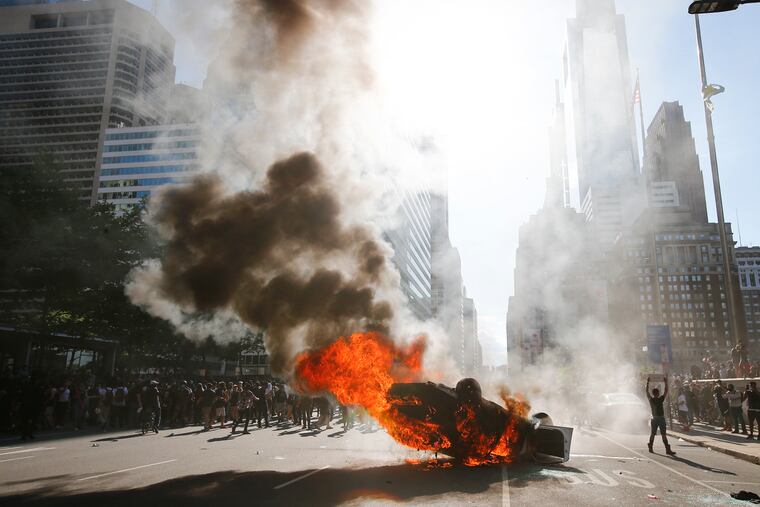Philly police were ‘simply not prepared’ for George Floyd protests, review finds
The report said initial mistakes by the Police Department had “cascading effects,” including officers using tear gas and excessive force as demonstrations spread across the city.

The Philadelphia Police Department and city officials “were simply not prepared” for large-scale protests this summer after George Floyd was killed by Minneapolis police, leaving police short-staffed, lacking equipment, and without a suitable plan to respond to demonstrations that quickly grew in size and intensity and lasted several days, according to a review commissioned by Mayor Jim Kenney.
As a result, the review found, the Police Department’s initial planning mistakes had “cascading effects” as demonstrations spilled into areas including West Philadelphia and I-676, including “inordinate use of gas and other munitions” by police, and “at times excessive force against protesters.”
The 110-page report, released Wednesday afternoon, provides another accounting of a series of events that drew national criticism. For nearly three days starting May 30, demonstrations against police brutality quickly led to scenes of chaos and confusion unlike anything seen in the city in years.
Police struggled to control crowds in Center City, as some people resorted to looting or property destruction. Officers deployed tear gas and rubber bullets against protesters on 676 and into a predominantly Black residential neighborhood in West Philadelphia amid civil unrest. A commander was arrested after being caught on video beating a protester, and another officer was charged for pepper-spraying a demonstrator. And as police were accused of fueling chaos elsewhere, officers in Fishtown were criticized for failing to stop it, allowing white men to freely walk the streets while carrying bats.
Kenney said in a statement Wednesday: “I fully accept the criticisms in the report of how our administration conducted itself this past summer,” adding that he believed the report “provides a comprehensive blueprint for long-lasting police and emergency response reform in the city.”
Police Commissioner Danielle M. Outlaw said many of the suggestions from the report — authored by CNA, a research organization, and the law firm Montgomery McCracken Walker & Rhoads LLP — were already being implemented. The 77 recommendations included enhanced training, better equipment such as body-worn cameras, and renewed efforts to build community trust. Few contained specific price tags.
Mike Dunn, a city spokesperson, said the report cost about $268,000 to produce. The authors said they reviewed more than 3,600 documents and hundreds of hours of audio and video, and conducted 59 interviews with police department and city staff and community members.
The report said that after the killing of Floyd, police in other cities were similarly surprised by protests that turned more volatile than expected. It also acknowledged that planning for events this year was more challenging due to the coronavirus pandemic.
Still, the report was plain in its assessment that errors at the beginning of the planning process were key in hindering the department’s overall response.
“The chaos and uncertainties over the first three days of the response led to questionable uses of tear gas, and breakdowns in crowd management plans and tactics,” it said.
The report said the department had been notified on May 29 by a regional intelligence agency that the Black Lives Matter movement was planning a demonstration at City Hall the next day. The city should expect anywhere from 1,400 to 3,600 attendees, the intelligence advised.
The department deployed just 53 officers for the protest.
The report called the planning “narrowly focused,” and said it suffered from key command vacancies, miscommunication, and a lack of proper support services.
What began as a peaceful protest in the afternoon deteriorated as the day wore on. Police cars outside City Hall were set on fire, a crowd sought to tear down the Frank Rizzo statue outside the Municipal Services Building, and dozens of stores were damaged and looted as officers clashed with demonstrators into the night.
The next day, demonstrations continued to spread across the city, including into West Philadelphia and Kensington. On-scene police supervisors received little direction — or backup — from department commanders, the report found, and their calls and emails for orders sometimes went unanswered.
As the unrest continued, the report said, the department failed to employ an effective centralized command post. And the woeful lack of manpower had “notable impacts” on the department’s ability to effectively stem looting and ensure safety, it said. The planning was so inadequate that many districts didn’t even have enough police radios, the report found.
Even some of the biggest decisions were marked by lack of coordination. Tear gas was deployed three times during the unrest that lasted into June 1, the report said: in West Philadelphia, on 676, and in Kensington. Outlaw was notified beforehand only once, the report said — for use in West Philadelphia, which she approved.
She and Kenney have previously apologized for the use of tear gas against protesters on 676, calling it “unjustifiable” and admitting they had offered incorrect and uncorroborated explanations for why officers had resorted to the tactic.
Still, the report said the combination of events across the city further damaged community trust in a city where public confidence in law enforcement has long been a challenge. And it said the department must build better relationships with the community as it works toward reform moving forward.
“It became clear from these interviews,” the report said, “that there remains a significant lack of trust in PPD in segments of the Philadelphia community.”